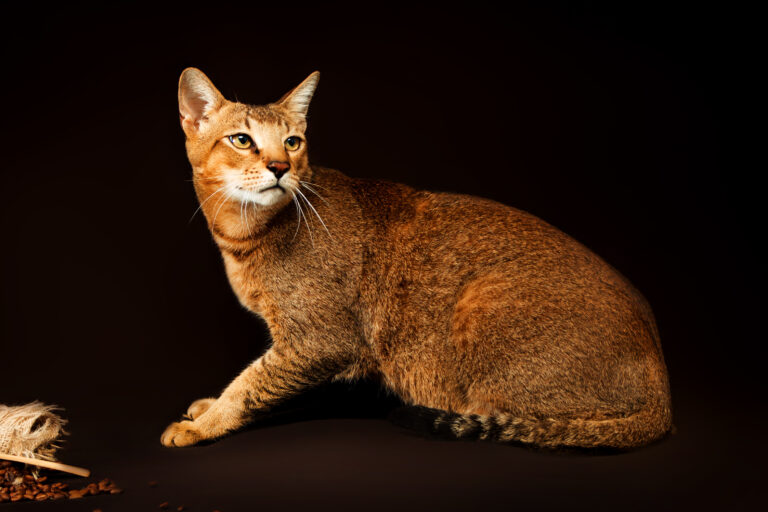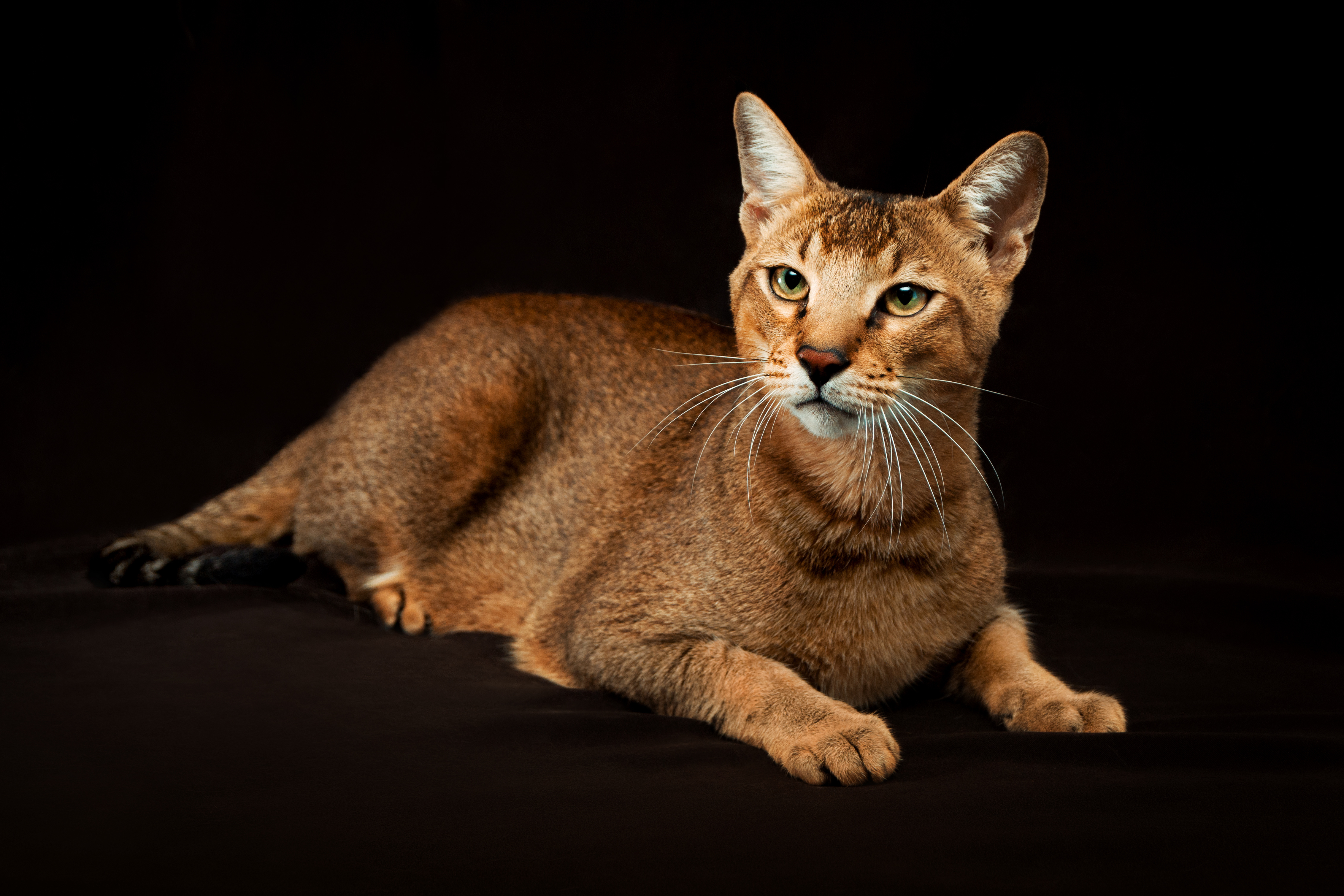Maine Coon
The Maine Coon has now become one of the most popular cat breeds in the world and is enjoying increasing popularity in Ireland, too. This is probably thanks to its authenticity, robustness and excellent character.
The Chausie is a hybrid breed with a cross between domestic and jungle cats. It is said to combine the proud appearance of wild cats with the loyal and people-focused nature of domestic cats. The rare Chausie has well-defined cheekbones and has maintained its ancestors' desire for exercise and freedom to this day.

The Chausie’s wild genes have left their mark on the diet and behavior of these exotic cats. However, they are most significant in terms of the breed’s physical appearance. Just like the Egyptian jungle cat, its direct ancestor, the Chausie has a very athletic physique. The breed’s long legs, slightly longer at the rear, reveal what good runners and high jumpers these pedigree cats are. Their wedge-shaped head with strongly defined cheekbones and widely spaced eyes gives an exotic look. Their strong chin and rounded ears with striking tufts of hair bring to mind the lynx.
In contrast to the lynx and other hybrid cats like the Savannah or Caracal, the Chausie doesn’t have striking markings. Its short to medium-length fur is banded and mostly brown or black, though can also be silver. Possible colors can be divided into the following three shades:
The Chausie’s stomach and prominent chin are mostly much lighter than the rest of the fur. Its walnut-shaped eyes are usually gold or yellow, though can also be hazelnut-brown or light green.
Humans have wished to tame feline predators for a long time. A consequence of this was breeding what were known as hybrid cats, which began in the 1960s. Scientists and cat breeders aimed to combine the exotic appearance of wild cats with the loyal and people-focused nature of domestic cats. Hence, the demand for more exotic cats has constantly increased since then. With half wild blood and officially recognized by the TICA (The International Cat Association) as a pedigree cat since 1995, the Chausie has made a name for itself within this trend. However, it is still a rare collector’s cat outside of the US, the country in which breeding originated.
Firstly, anyone interested in a Chausie must be aware that hybrid cats come at a cost due to their rarities and the complexity of breeding. Depending on the generation and its proportion of wild blood, a pedigree Chausie from a serious, responsible breeder costs between € 7,500 and € 10,000. If you’re going to be paying so much, you should be convinced that this pedigree breed is the right one for you. But what defines a Chausie? How wild is it really and what demands does it present its future owner as a domestic cat?
Despite its wild appearance, the Chausie is an incredibly affectionate cat that loves being in close proximity to its family. Therefore, it will occasionally be struck by hunting fever. On long exploratory tours, it will hunt mice and birds and it isn’t uncommon for it to bring home a little “gift” for its owners in the form of price. Hence, these friendly and open domestic cats are still made up of plenty of wild cat and their future owners should be aware of this. Nothing harms these curious and lively cats more than boredom and being alone. Sufficient activity with cat toys , a scratching tree and plenty of exercise are essential to “tame” these wild cats.Hence, keeping several cats certainly meets the breed’s need for entertainment and diversity.
In contrast to some other domestic cats, the Chausie likes to be at the center of things. Hence, it gets on well with children, as they are both as playful as one another. However, their love for children shouldn’t be tested too much, because the self-confident and temperamental Chausie can show its aggressive side if something doesn’t suit it. Therefore children should give these wild cats their space and respect their urge to go outside to hunt. After all, the intelligent Chausie knows best of all what it likes. If its urge for exercise is satisfied, it will then happily lie down on the couch and show its loving and affectionate side.
 © tania_wild / stock.adobe.com
© tania_wild / stock.adobe.com
This temperamental and active cat shouldn’t be holed up indoors. Out of love for their pet and consideration for its natural urges, owners should allow their chausie regular outdoor access. A cat flap in the door that allows your cat to go in and out of its own accord is the best solution. Solely living indoors isn’t an ideal option for the Chausie. Unless, you equip it with a big open-air enclosure in which these cats can climb, jump and run. If you want it to stop it from leaving the enclosure, it must be well secured, because a chausie can easily jump two meters or higher from a standing position.However, you should consider whether the Chausie really is the right cat for you before putting in place such complex security measures. After all, these wild hybrid cats carry the hunting instinct in their blood and shouldn’t be inhibited.
If you give your Chausie outdoor access in a manner appropriate to the species, you should nevertheless focus on sufficient immunization (against rabies and leucosis) as well as preventive measures against parasite infestations . There are special collars or remedies that effectively counteract parasite infestations. Ask your vet for advice and attend annual preventive check-ups. Cats tend to retain illnesses and complaints for a long time. Regular check-ups with specialists can help to identify and treat possible ailments at an early stage. Although there are thankfully hardly any known diseases typical of the Chausie breed, these pedigree cats aren’t immune to typical feline ailments such as diseases of the upper respiratory tract or gastroenteritis. You should vaccinate cats against cat colds and flu.
Along with necessary preventive trips to the vet or vaccination boosters, caring for a chausie is very manageable. Like all short-haired cats, it takes care of its grooming more or less by itself. Hence, combining it on a weekly basis to remove all dead hairs is more than sufficient. In addition, to recognize potential anomalies at an early stage, you should also regularly check your Chausie’s paws, claws, snout and skin. With good care and species-appropriate housing, these robust and resistant cats can live to be up to 16 years of age.
With such a primal breed as the Chausie, its requirements in terms of food are somewhat more challenging than with a normal domestic cat. Many owners of hybrid breeds claim that their cat doesn’t tolerate industrially manufactured food and switch to raw food ( BARF ). However, BARF demands expert knowledge to optimally cover your pet’s nutritional requirements. If this diet is too complicated for you, you should look for a high-quality food with a high proportion of meat (rich in protein), fresh fruit and vegetables and natural oils. Due to possible intolerances, the proportion of grain in the food should be as low as possible or entirely absent.Many hybrid breeds allowed outdoor exercise for hunting eat mice or small birds as a supplement to their food which should be taken into consideration when calculating the right amount of food.
Discover our selection of dry cat food and wet cat food !
However, the Chausie’s attractive wild cat appearance comes at a cost. Pairing domestic and wild cats isn’t straightforward and is highly controversial amongst animal rights activists in particular. The main reason for this criticism is the fact that gestation periods differ greatly between domestic and wild cats. Whilst domestic cats have a gestation period of 63 to 65 days, wild cats are pregnant for much longer, around 76 to 78 days. The consequence of this discrepancy is that there are many premature births, miscarriages and stillbirths amongst the first generation (F1) in particular. There are often difficult births or caesareans amongst the following generations (F2 and F3) too. As a result, working with such hybrid breeds is incredibly difficult and should only be carried out be experts. In some countries, a licence is required for owning wild cat hybrids up to and including the fourth generation (F4).
If you’re considering buying a Chausie, you should research the breeding and ownership requirements beforehand. Unfortunately, a lack of knowledge or buying “bargains” from unscrupulous breeders often have tragic consequences. It’s not uncommon for poor ownership to lead to noticeable behaviour disorders and overwhelmed owners.
Before buying a Chausie, you should ensure that this cat will be able to satisfy its natural urges for freedom and exercise whilst not getting bored. Sufficient opportunities to play, possibly a fellow cat as a playmate and time shared with the family is essential for living in harmony, since this breed loves its family as much as it does exercise. In conclusion, if you keep this breed in a species-appropriate manner, you’ll be rewarded with an incredibly affectionate cat that will be loyal to you.
The Maine Coon has now become one of the most popular cat breeds in the world and is enjoying increasing popularity in Ireland, too. This is probably thanks to its authenticity, robustness and excellent character.
Neva Masquerade – a mysterious name for a mysterious thing of beauty! The Neva Masquerade is the point variation on the Siberian cat and shares many characteristics with this breed.